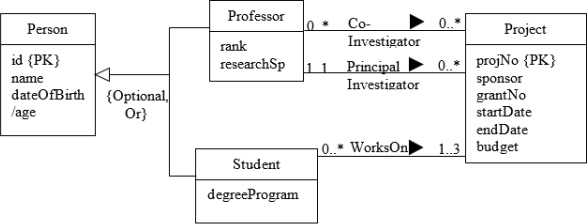INFO6002 Database Management 2
Hello, dear friend, you can consult us at any time if you have any questions, add WeChat: daixieit
School of Information and Physical Sciences
SAMPLE EXAMINATION
INFO6002 Database Management 2
Question 1.
Consider the following EER diagram. Map it to the relational model. Specify the relational schema in DBDL notation.
(a.)

(b.) Consider the following relation schema of the Student relation:请看下面的学生关系模式:
Student (stdNo, sName, address, phone, major, dept)
AttributestdNo is the only candidate key of the relation. The following functional dependencies exist:
stdNo ![]() stdNo, sName, address, phone, major, dept
stdNo, sName, address, phone, major, dept
major ![]() dept
dept
If the relation is not already in Boyce-Codd Normal Form (BCNF), provide lossless join decomposition to BCNF. Show the steps of your decomposition. Otherwise, justify your answer.
Question 2.
Consider the following relational schema:
(empId INT PRIMARY KEY, Employee Id
empName VARCHAR(100), -- Employee name
salary FLOAT, -- Employee salary
dno INT, -- Department employee works in
managerId INT REFERENCES Employee(empId)) -- Employee Id of employee's manager
go
Employee table stores information about employees working in ABC company. For each employee, an employee id (empId), employee’s name (empName), salary (salary), department number of department employee is working in (dno) and manager’s employee id (managerId) are maintained.
Write the Transact-SQL (T-SQL) statement to do the following:
(a.) Print the names of employees making the highest salary for each department
(b.) The following business rule needs to be enforced:
A manager's salary is always greater than his/her subordinates
The following trigger does not always enforce the business rule (for example, when the salary of manager is equal to the subordinate).
CREATE TRIGGER enforceSalaryBusinessRule
ON Employee
FOR INSERT, UPDATE
AS
BEGIN
DECLARE @salary FLOAT
DECLARE @managerSalary FLOAT
DECLARE @managerId INT
-- Declare the cursor
DECLARE employeeCursor CURSOR
FOR Employee
FROM
FOR READ ONLY
-- Populate the cursor
OPEN employeeCursor
-- Fetch the first rom
FETCH NEXT FROM employeeCursor INTO @managerId, @salary
WHILE @@FETCH_STATUS = 0
BEGIN
SELECT @managerSalary = salary
FROM Employee
WHERE eid = @managerId
IF @salary > @managerSalary
BEGIN
ROLLBACK TRANSACTION
RAISERROR (N'Manager''s salary is less than employees salary',
9, 1)
END
-- Fetch the next rom
FETCH NEXT FROM employeeCursor INTO @managerId, @salary
END
CLOSE employeeCursor
DEALLOCATE employeeCursor
END
Review the above code for the trigger. Fix the above trigger so that the business rule is always enforced.
Question 3.
Consider the following schedule. Note that T1 and T2 denote transactions: (a.) Find issues (e.g. conflicts, anomalies, etc.) in the following schedule.

(b.) What is meant by a cascading abort? What is the cause for a cascading abort? Give an example of a schedule with a cascading abort. How does Strict 2PL protocol avoid cascading aborts?
Question 4.
(a.) Inmon (1993) described a Data Warehouse as a “subject-oriented,
integrated, time-variant, non-volatile collection of data”. Explain each of these terms and why a data warehouse needs these properties.
(b.) Describe how star, snowflake, and starflake schemas differ.
Question 5
Consider the following table
Account(accNo, acName, balance, openedDate)
accNo is the primary key in the Account table. There are 1,000,000 accounts in the table distributed equally in 10,000 pages on disk. Assume that an unclustered B+ Tree index with search key <accNo, balance> exists with height 2.
The query shown below, which obtains the balance for a given account number, is run very often and is important that it runs as efficiently as possible.
SELECT balance
FROM Account
WHERE accNo = ‘xxxx’
Would using the unclustered B+ tree index described above for this query be beneficial? Explain your answer by estimate the cost in terms of disk I/Os for the query plans considered.
2023-07-22